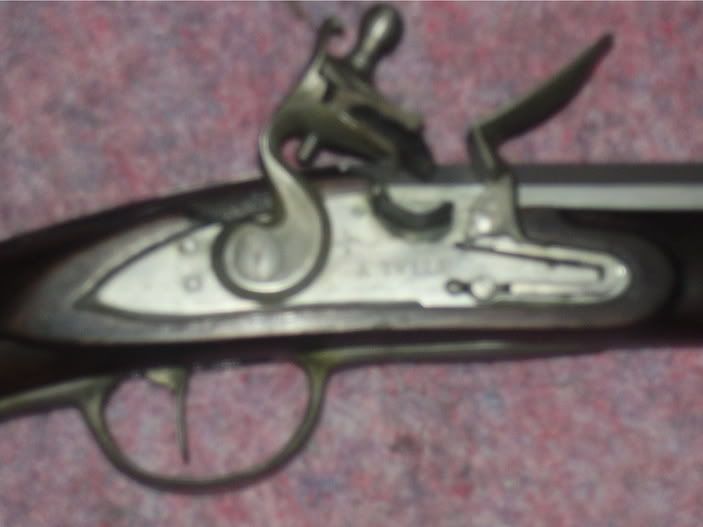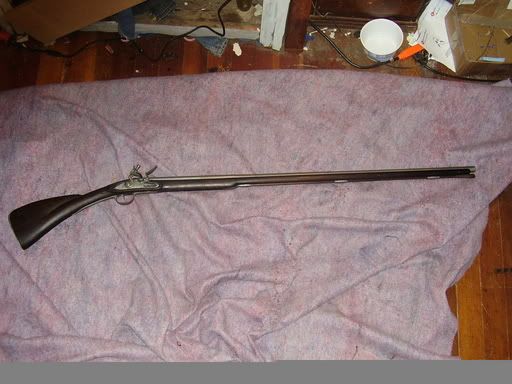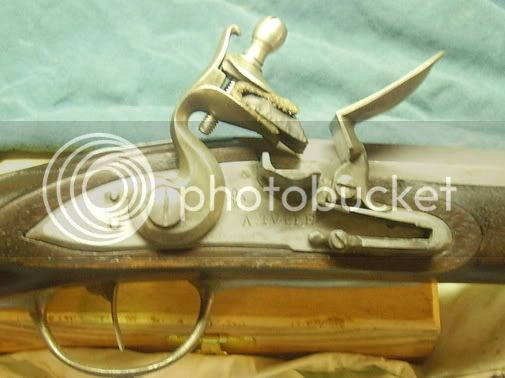-
Friends, our 2nd Amendment rights are always under attack and the NRA has been a constant for decades in helping fight that fight.
We have partnered with the NRA to offer you a discount on membership and Muzzleloading Forum gets a small percentage too of each membership, so you are supporting both the NRA and us.
Use this link to sign up please; https://membership.nra.org/recruiters/join/XR045103
You are using an out of date browser. It may not display this or other websites correctly.
You should upgrade or use an alternative browser.
You should upgrade or use an alternative browser.
de Chase
- Thread starter tg
- Start date

Help Support Muzzleloading Forum:
This site may earn a commission from merchant affiliate
links, including eBay, Amazon, and others.
Nicely done! Were you pretty happy with the kit?
tg: Nicely done!! 
Would it be possible for you to post a close-up of the lock?
I keep hearing that there are no locks which closely duplicate the French style Flintlock, and it would be very interesting to see what you had to do to make it more authentic.
Thank You
Jim
Would it be possible for you to post a close-up of the lock?
I keep hearing that there are no locks which closely duplicate the French style Flintlock, and it would be very interesting to see what you had to do to make it more authentic.
Thank You
Jim
The parts set was a nice one with the buttplate partialy inlet and the lock inlett very close, I had a friend help with much of the lock/barrel fitting and shaping of the stock as it was square ahead of the lock panels and a bumb shoulder has limited what I want to do on a gun project anymore. If this pic is not clear enough I will try to get a macro pic if I can figure that function out on the digital gcamera, one might be able to zoom in on the lock from the gun pic as well if it was placed in an editing program???


Thanks.
I tryed a screengrab but it seems my Photoshop can't sharpen it enough.
It would appear the bottom of the pan is rounded rather than having the Germanic flats. Is this true?
I'm not sure I can make out the other shape differences, but these old eyes aren't as sharp as they once were.
As for the micro on a Digital, mine is good for distances of 2 inches to 1.5 feet (or 10 inches to 1.5 feet using telephoto), but the problem I've had is at that distance, the flash often washes out the image.
It seems to work best in bright natural light.
You might want to try a distance of about 2 1/2 feet with the flash?
Thanks again for trying. :thumbsup:
I tryed a screengrab but it seems my Photoshop can't sharpen it enough.
It would appear the bottom of the pan is rounded rather than having the Germanic flats. Is this true?
I'm not sure I can make out the other shape differences, but these old eyes aren't as sharp as they once were.
As for the micro on a Digital, mine is good for distances of 2 inches to 1.5 feet (or 10 inches to 1.5 feet using telephoto), but the problem I've had is at that distance, the flash often washes out the image.
It seems to work best in bright natural light.
You might want to try a distance of about 2 1/2 feet with the flash?
Thanks again for trying. :thumbsup:
The bottom of the pan is kind of rounded/triangled, the decorations are filed off the front of the frizzen, the finial on the frizzen spring has been removed, the notch out shape above the mounting screw on the cock where it mounts to the lock plate has been changed to a smooth arc and the thumb screw has been made more slender, I will try to get a more focused pic, if I get a nice sunny day outside may be the ticket.
Guest
Hats off to you ! Any attempt I had with putting something together was to make 30.00 (Canadian) out of 500.00 (US) worth of parts. Envy you and proud of your accomplishment.
- Joined
- Aug 25, 2003
- Messages
- 6,473
- Reaction score
- 1,394
Very nice TG,very nice. Always liked the shape of those. Good work. Take care
Thanks all for the kind words, I do not consider myself a gunbuilder by any means, maybe a novice gunstocker...I know my limitations and am fortunate to have a friend who is a top notch builder close by when serious thinking and talent (and two good arms) is required. I do not think I would take on a blank piece of wood and try to make a gun out of it, the extent that I do work on guns does give me a great respect for those who start from scratch
- Joined
- Apr 3, 2004
- Messages
- 15,602
- Reaction score
- 19
Very nice TG, I've been looking forward to seeing this project of yours since you first said you were doing it. I really want to see the work you did to that lock to make it right. Hopefully you can get a good clear pic for us??
I like it......I like it alot!
I want to order the same kit from TOW sometime this summer (except I want the 16 guage barrel), so I have few newbie questions for you.
How did you stain the stock?
How much inletting was left to do on the buttplate?
I want to order the same kit from TOW sometime this summer (except I want the 16 guage barrel), so I have few newbie questions for you.
How did you stain the stock?
How much inletting was left to do on the buttplate?
Mostly I just had to remove wood from the back of the buttstock untill it fit into the inlet and also it needed the top inlet lowered a bit it was pretty easy compared to starting from scratch, I stainned the stock with LMF Walnut stain very dark after raising
the grain three times, then took the stain down to my likeing with steel wool, then I put on a thick coat of linseed oil, turp, spar varnish and roof tar (asphaultum) and after it dried, sanded it down with 600 grit this somewhat filled the pores and gave it a oldie, used, dirty look in places. then I finished it off with BC true oil wooled down betwwen coats with fine steel wool,( a mix of lin oil, turp, and spar varn would work as well but I was out so I used up an old bottle of BC that was on the shelf) then burnished it down with a smooth deer antler, followed by a very light coat of stock wax hand rubbed till dry and buffed down with the suede side of a piece of deer hide. I was looking for a bit of an aged look and something diferent than the fancy high grade finishes most use today. I have done several guns this way or close to it I vary things a bit from time to time according to what I have on hand and what strikes me as a thing I want to try.
the grain three times, then took the stain down to my likeing with steel wool, then I put on a thick coat of linseed oil, turp, spar varnish and roof tar (asphaultum) and after it dried, sanded it down with 600 grit this somewhat filled the pores and gave it a oldie, used, dirty look in places. then I finished it off with BC true oil wooled down betwwen coats with fine steel wool,( a mix of lin oil, turp, and spar varn would work as well but I was out so I used up an old bottle of BC that was on the shelf) then burnished it down with a smooth deer antler, followed by a very light coat of stock wax hand rubbed till dry and buffed down with the suede side of a piece of deer hide. I was looking for a bit of an aged look and something diferent than the fancy high grade finishes most use today. I have done several guns this way or close to it I vary things a bit from time to time according to what I have on hand and what strikes me as a thing I want to try.
TG: Thank you for the picture. 
To those who are new to the building of muzzleloaders, let me say something about the finish.
There are several materials out there which do a great job. Of course polyurathane and lacquer are out, but some of the old time materials are available and things like True-Oil are simply linseed oil with dryers added are relatively PC. (The use of dryers in oil goes back in time as far as some of the earliest oil paintings).
One of the interesting things about the finishes is no one really knows exactly how many of the old guns were finished.
This leaves an area of creativity where new methods and combinations may be tried using the old types of materials as TG did.
I personally don't want to use asphaultum on my guns, but I'm not trying to use the methods which make the appearance of the gun look really old either. If you are trying to create a 200 year old look, you might want to try it.
(The black appearance on many old guns is the result of the oils originally used blacking due to 150-250 years of oxidation.)
To those who are new to the building of muzzleloaders, let me say something about the finish.
There are several materials out there which do a great job. Of course polyurathane and lacquer are out, but some of the old time materials are available and things like True-Oil are simply linseed oil with dryers added are relatively PC. (The use of dryers in oil goes back in time as far as some of the earliest oil paintings).
One of the interesting things about the finishes is no one really knows exactly how many of the old guns were finished.
This leaves an area of creativity where new methods and combinations may be tried using the old types of materials as TG did.
I personally don't want to use asphaultum on my guns, but I'm not trying to use the methods which make the appearance of the gun look really old either. If you are trying to create a 200 year old look, you might want to try it.
(The black appearance on many old guns is the result of the oils originally used blacking due to 150-250 years of oxidation.)
I had an old 30-30 saddle gun circa 1930 when I was in high school that had that same darkened areas here and there so I would not say that the method I used will absolutely give the 200 year old look, and you can tone it down to give the look you wish, it is a manure shoot as to what one of these guns would look like after 30-40 years of use as there are so many variables it is also hard to tell what a 200 year old gun looked like 160 years ago, all we know is what they look like now. I suggest that anyone wishing to age a gunstock or furniture try some testing first to see how it looks to their tastes. If I were trying to replicate a new gun in 1770 I would opt for a new gun look which many do and they look very good, as I am trying to create a gun for a 1760-70 persona that was made in 170-30 I did not think the fresh off the boat look was proper so I tried to get what my interpretation of some age was into it, this is a subjective thing that each must decide what looks "right", and a pic cannot tell the story like holding it in your hands so do some testing first with any aging or patina type finish.
- Joined
- Apr 3, 2004
- Messages
- 15,602
- Reaction score
- 19
Nice, I see what you did to the lock now. You have stamps made up for the "fleur-de-lis" and the TULLE? That really makes it a fusil de chasse. :thumbsup:
I keep looking at the fusil de chasse on page 46 of Hamilton's book and seems to me one could modify a Chambers Christian's Spring lock to closly look like the original. If the bottom hump on at the rear of the plate could be lessened. :hmm:
I keep looking at the fusil de chasse on page 46 of Hamilton's book and seems to me one could modify a Chambers Christian's Spring lock to closly look like the original. If the bottom hump on at the rear of the plate could be lessened. :hmm:
The radical arch of the bottom of the plate is a tough change to make to get the Germanic locks to fit the French style post 1720, that is what they have tried to do with the type C and D guns from TOW and they fall short, the modified Davis Tulle lock or some use the L&R trade lock comes a lot closer, I think the Davis lock is closer than the L&R to most pics of originals, the lettering and Fleurdelis was engraved by hand by that friend of mine whose talent greatly exceeds my own in such areas.
Similar threads
- Replies
- 8
- Views
- 640
- Replies
- 0
- Views
- 55
- Replies
- 9
- Views
- 2K
- Replies
- 5
- Views
- 858
SOLD - Pending funds
.54 HAWKEN KIT $390 shipped!!
- Replies
- 19
- Views
- 851





